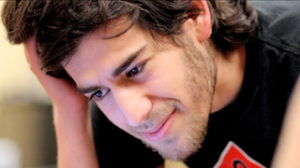The time that I started to think about media, coincided with Aaron Swartz‘s suicide, key architect of Creative Commons and an organizer of the grassroots movement to defeat the controversial House Internet censorship bill

the Stop Online Piracy Act (SOPA), and the Senate bill, the PROTECT IP Act (PIPA). Swartz hanged himself just weeks before the start of a controversial trial. This incident sheds light in how we understand relationships between media, democracy, journalism and propaganda on one hand and how does resistance and activism fit into this picture.
In his speech about participatory democracy, Dr. Chris Hables Gray mentioned that Participatory selection is a third way to Evolution and Selection, following Natural and Artificial selection. He also mentioned that participatory selection is the only way to influence culture and ultimately humanity. As Jodi Dean puts it, the very premise of liberal democracy is the sovereignty of people so the question we need to raise here is whether participatory democracy is even possible, and if is, what does it look like?
To better understand the meaning of participatory democracy, we can turn to the explanation of totalitarianism by Micheal Warner, as a nonkin society organized by bureaucracy and law. Everyone’s position, function, and capacity for action are specified by administration. Basically the public sphere in totalitarianism is non-existent. I personally have witnessed this reality in Albania, where not only the public sphere was non-existent, but also propaganda had a positive connotation. This means that the public understood the communist propaganda as some form of ideology (positive connotation as well) that protected us from the corrupt capitalism. Nevertheless, as a child I didn’t know that I was completely absorbed by the propaganda, to that extent that even at this age, I smile involuntarily when I see the picture of the dictator that killed many people, including people in my close family. This kind of propaganda is exactly what Jacques Ellul describes as “Propaganda must become as natural as air or food. It must proceed by psychological inhibition and the least possible shock. The individual is then able to declare in all honesty that no such thing as propaganda exists. In fact, he has been so absorbed by it that he is literally no longer able to see the truth”.
On the other hand, liberal democracy propagates the autonomy of the political institutions from the economic, cultural and social – sexual institutions, but the problem is that the inherent inequalities in the latter institutions will manifest themselves in the participation and contribution in the public sphere. The idea of the publics and the counterpublics is essential when we talk about the public sphere, in that that counterpublics maintain an awareness of its subordinate or “subaltern” status. The participatory parity is better achieved by a multiplicity of publics than a single public. In an egalitarian multi-cultural society there is a multiplicity of publics, not necessarily stratified. Public discourse and social identities are not just a matter of being able of stating certain content, but rather expressing one’s cultural identity through idiom and style. The public sphere cannot be a single comprehensive one.
How does the public sphere and participation look like in communicative capitalism and what’s the impact of networked communications technologies? First of all, in the communicative capitalism, politics is understood in two forms, in that of the official politics, and in the form of circulation of content. The latter is the very essence of the communicative capitalism, as it focuses on the exchange value of the contribution rather than use value of it. In essence, the communicative capitalism tries to capture the strange merging of democracy and capitalism through networked communications. In this merging, the publics have a different characteristics and fantasies, such as the fantasy of abundance, which leads to the importance of circulation than message, the fantasy of participation, where in fact by fetishizing technology we believe that the technology will act for us, and the fantasy of the wholeness or unity as the global. These fantasies are dangerous in that they not only depoliticize the public, but they create an imaginary site for action and belonging. These fantasies are also very dangerous in the sense that they exclude the role of the mainstream Media as a very powerful tool of propaganda. Naom Chomsky’s video about the Myth of the Liberal media points out that unless people are controlled they will challenge power, and there are two ways to accomplish this: through force or the control of opinion. The fantasy of freedom is masked under certain freedoms, such as the freedom to vote, of speech etc. But as Henry David Thoreau: “Cast your whole vote, not a strip of paper merely, but your whole influence”.
Although there are many forms of restrictions to the counterpublics, there is still hope on an engaged public and activism The example of Aaron Swartz, although an unfortunate one, shows that there are always pockets of resistance towards any kind of restrictiono to partake in the public sphere, and ultimately democracy. Trying to answer the initial question whether participatory democracy is possible, I think that it’s very important to understand these fantasies surrounding our agency, listening to subaltern voices as much as possible as means to understand the “publics” and finally trying to find your voice by participating in this multidimensional sphere that’s called public.
Bruce Levine’s article about mental illness, shows how the institutionalization of consent is made possible “Why Anti-Authoriarians are considered to be mentally ill” and as Naom Chomsky shows in this video, consent is rather produced than inherent in the public “Manufactured consent” . Therefore, the role of Public Intellectuals and activists is very crutial, not merely as an opposing force, but as an eye opener and educator for the broader public.